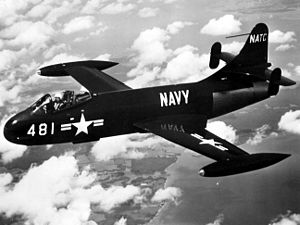
The McDonnell FH Phantom is a twinjet fighter aircraft designed and first flown during World War II for the United States Navy. The Phantom was the first purely jet-powered aircraft to land on an American aircraft carrier and the first jet deployed by the United States Marine Corps. Although only 62 FH-1s were built it helped prove the viability of carrier-based jet fighters. As McDonnell's first successful fighter, it led to the development of the follow-on F2H Banshee, which was one of the two most important naval jet fighters of the Korean War; combined, the two established McDonnell as an important supplier of navy aircraft.

The McDonnell XF-88 Voodoo was a long-range, twinjet fighter aircraft with swept wings designed for the United States Air Force. Although it never entered production, its design was adapted for the subsequent supersonic F-101 Voodoo.

The McDonnell F2H Banshee is a single-seat carrier-based jet fighter aircraft designed and produced by the American aircraft manufacturer McDonnell Aircraft. It was an early jet fighter operated by United States Navy and United States Marine Corps, as well as being the only jet-powered fighter to ever be deployed by the Royal Canadian Navy. The aircraft's name is derived from the banshee of Irish mythology.
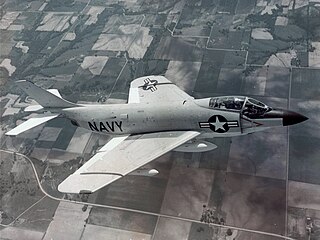
The McDonnell F3H Demon is a subsonic swept-wing carrier-based jet fighter aircraft designed and produced by the American manufacturer McDonnell Aircraft Corporation. It was the first swept wing jet fighter and the only single-engined carrier-based fighter the company produced.
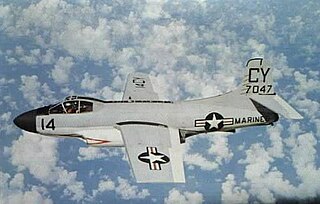
The Douglas F3D Skyknight is an American twin-engined, mid-wing jet fighter aircraft designed and manufactured by the Douglas Aircraft Company.

The Douglas F4D Skyray is an American carrier-based fighter/interceptor designed and produced by the Douglas Aircraft Company. It was the last fighter produced by the Douglas Aircraft Company prior to its merger with McDonnell Aircraft to become McDonnell Douglas.
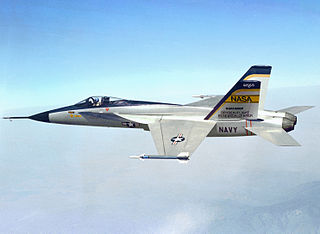
The Northrop YF-17 was a prototype lightweight fighter aircraft designed by Northrop aviation for the United States Air Force's Lightweight Fighter (LWF) technology evaluation program. The LWF was initiated because many in the fighter community believed that aircraft like the F-15 Eagle were too large and expensive for many combat roles. The YF-17 was the culmination of a long line of Northrop designs, beginning with the N-102 Fang in 1956, continuing through the F-5 family.

The Convair F2Y Sea Dart was an American seaplane fighter aircraft that rode on twin hydro-skis during takeoff and landing. It flew only as a prototype, and never entered mass production. It is the only seaplane to have exceeded the speed of sound.

The Ryan FR Fireball was an American mixed-power fighter aircraft designed by Ryan Aeronautical for the United States Navy during World War II. It was the Navy's first aircraft with a jet engine. Only 66 aircraft were built before Japan surrendered in August 1945. The FR-1 Fireball equipped a single squadron before the war's end, but did not see combat. The aircraft ultimately proved to lack the structural strength required for operations aboard aircraft carriers and was withdrawn in mid-1947.
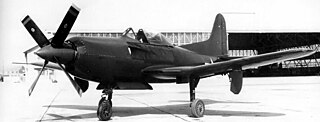
The Ryan XF2R Dark Shark was an American experimental aircraft built for the United States Navy that combined turboprop and turbojet propulsion. It was based on Ryan Aeronautical's earlier FR Fireball, but replaced the Fireball's piston engine with a turboprop engine.

The Vought F7U Cutlass is a United States Navy carrier-based jet fighter and fighter-bomber designed and produced by the aircraft manufacturer Chance Vought. It was the first tailless production fighter in the United States as well as United States Navy's first jet equipped with swept wings and the first to be designed with afterburners.
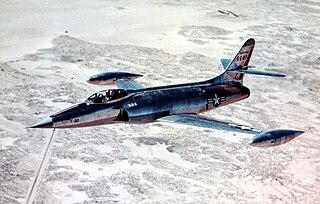
The Lockheed XF-90 was built in response to a United States Air Force requirement for a long-range penetration fighter and bomber escort. The same requirement produced the McDonnell XF-88 Voodoo. Lockheed received a contract for two prototype XP-90s. The design was developed by Willis Hawkins and the Skunk Works team under Kelly Johnson. Two prototypes were built. Developmental and political difficulties delayed the first flight until 3 June 1949, with Chief Test Pilot Tony LeVier at the controls. Embodying the experience gained in developing the P-80 Shooting Star, the XF-90 shared some design traits with the older Lockheed fighter, albeit with swept-wings; however, this latter design choice could not sufficiently make up for the project’s underpowered engines, and the XF-90 never entered production.

The Grumman XF10F Jaguar was a prototype swing-wing fighter aircraft offered to the United States Navy in the early 1950s. Although it never entered service, its research paved the way toward the later General Dynamics F-111 and Grumman's own F-14 Tomcat.

The Yakovlev Yak-19 was a prototype Soviet fighter built in late 1940s. It was the first Soviet aircraft to be equipped with an afterburning turbojet, the Klimov RD-10F that was derived from the German Jumo 004 engine. Only two examples were built as it was rejected for service by the Soviet Air Force.

The Westinghouse J40 was an early high-performance afterburning turbojet engine designed by Westinghouse Aviation Gas Turbine Division starting in 1946 to a US Navy Bureau of Aeronautics (BuAer) request. BuAer intended to use the design in several fighter aircraft and a bomber. However, while an early low-power design was successful, attempts to scale it up to its full design power failed, and the design was finally abandoned, deemed a "fiasco" and a "flop".

The Arsenal VG 90 was a French carrier-based jet-engined interceptor developed in the late 1940s. It was intended to compete for an Aéronavale contract and first flew in 1949. It set a speed record for a French aircraft the following year, but both of the completed prototypes were destroyed in fatal crashes and the program was cancelled in 1952 before the third prototype was finished. The Aéronavale contract was eventually awarded to a license-built British aircraft. The remains of the last VG 90 were scrapped in 1978.

The North American FJ-1 Fury was an early turbojet-powered carrier-capable fighter aircraft used by the United States Navy (USN). Developed by North American Aviation (NAA) starting in 1945, it became the first jet aircraft in USN service to serve at sea under operational conditions. The FJ-1 was an early transitional jet of limited success which carried over similar tail surfaces, wing, and canopy derived from the piston-engined P-51D Mustang. The evolution of the design to incorporate swept wings would become the basis for the land-based XP-86 prototype - itself originally designed with a very similar straight-wing planform to the FJ-1 airframe - of the United States Air Force's enormously influential F-86 Sabre, which in turn formed the basis for the Navy's carrier-based North American FJ-2/-3 Fury.

The Westinghouse J34, company designation Westinghouse 24C, was a turbojet engine developed by Westinghouse Aviation Gas Turbine Division in the late 1940s. Essentially an enlarged version of the earlier Westinghouse J30, the J34 produced 3,000 pounds of thrust, twice as much as the J30. Later models produced as much as 4,900 lb with the addition of an afterburner. It first flew in 1947. The J46 engine was developed as a larger, more powerful version of Westinghouse's J34 engine, about 50% larger.

The Westinghouse J46 is an afterburning turbojet engine developed by the Westinghouse Aviation Gas Turbine Division for the United States Navy in the 1950s. It was primarily employed in powering the Convair F2Y Sea Dart and Vought F7U Cutlass. The engine also powered the land speed-record car known as the Wingfoot Express, designed by Walt Arfons and Tom Green It was intended to power the F3D-3, an improved, swept-wing variant of the Douglas F3D Skyknight, although this airframe was never built.
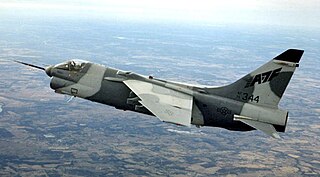
The Vought YA-7F "Strikefighter" is a prototype transonic attack aircraft based on the subsonic A-7 Corsair II. Two prototypes were converted from A-7Ds. The YA-7F was not ordered into production, its intended role being filled by the F-16 Fighting Falcon.
